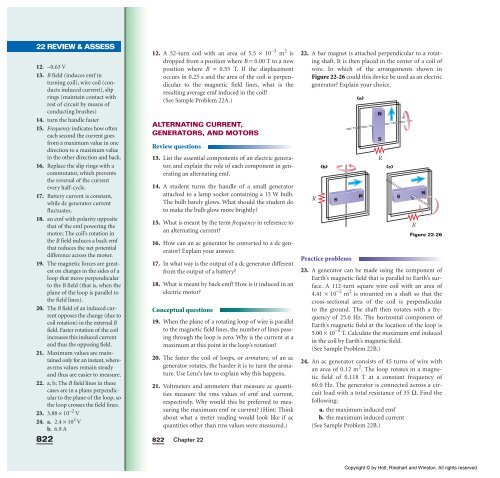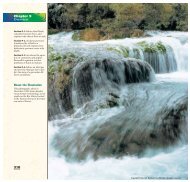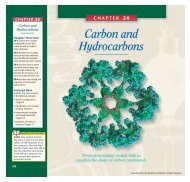Induction and Alternating Current with teacher's notes
Induction and Alternating Current with teacher's notes
Induction and Alternating Current with teacher's notes
Create successful ePaper yourself
Turn your PDF publications into a flip-book with our unique Google optimized e-Paper software.
22 REVIEW & ASSESS<br />
12. −0.63 V<br />
13. B field (induces emf in<br />
turning coil), wire coil (conducts<br />
induced current), slip<br />
rings (maintain contact <strong>with</strong><br />
rest of circuit by means of<br />
conducting brushes)<br />
14. turn the h<strong>and</strong>le faster<br />
15. Frequency indicates how often<br />
each second the current goes<br />
from a maximum value in one<br />
direction to a maximum value<br />
in the other direction <strong>and</strong> back.<br />
16. Replace the slip rings <strong>with</strong> a<br />
commutator, which prevents<br />
the reversal of the current<br />
every half-cycle.<br />
17. Battery current is constant,<br />
while dc generator current<br />
fluctuates.<br />
18. an emf <strong>with</strong> polarity opposite<br />
that of the emf powering the<br />
motor; The coil’s rotation in<br />
the B field induces a back emf<br />
that reduces the net potential<br />
difference across the motor.<br />
19. The magnetic forces are greatest<br />
on charges in the sides of a<br />
loop that move perpendicular<br />
to the B field (that is, when the<br />
plane of the loop is parallel to<br />
the field lines).<br />
20. The B field of an induced current<br />
opposes the change (due to<br />
coil rotation) in the external B<br />
field. Faster rotation of the coil<br />
increases this induced current<br />
<strong>and</strong> thus the opposing field.<br />
21. Maximum values are maintained<br />
only for an instant, whereas<br />
rms values remain steady<br />
<strong>and</strong> thus are easier to measure.<br />
22. a, b; The B field lines in these<br />
cases are in a plane perpendicular<br />
to the plane of the loop, so<br />
the loop crosses the field lines.<br />
23. 3.88 × 10 −2 V<br />
24. a. 2.4 × 10 2 V<br />
b. 6.9 A<br />
822<br />
12. A 52-turn coil <strong>with</strong> an area of 5.5 × 10 −3 m 2 is<br />
dropped from a position where B = 0.00 T to a new<br />
position where B = 0.55 T. If the displacement<br />
occurs in 0.25 s <strong>and</strong> the area of the coil is perpendicular<br />
to the magnetic field lines, what is the<br />
resulting average emf induced in the coil?<br />
(See Sample Problem 22A.)<br />
ALTERNATING CURRENT,<br />
GENERATORS, AND MOTORS<br />
Review questions<br />
13. List the essential components of an electric generator,<br />
<strong>and</strong> explain the role of each component in generating<br />
an alternating emf.<br />
14. A student turns the h<strong>and</strong>le of a small generator<br />
attached to a lamp socket containing a 15 W bulb.<br />
The bulb barely glows. What should the student do<br />
to make the bulb glow more brightly?<br />
15. What is meant by the term frequency in reference to<br />
an alternating current?<br />
16. How can an ac generator be converted to a dc generator?<br />
Explain your answer.<br />
17. In what way is the output of a dc generator different<br />
from the output of a battery?<br />
18. What is meant by back emf? How is it induced in an<br />
electric motor?<br />
Conceptual questions<br />
19. When the plane of a rotating loop of wire is parallel<br />
to the magnetic field lines, the number of lines passing<br />
through the loop is zero. Why is the current at a<br />
maximum at this point in the loop’s rotation?<br />
20. The faster the coil of loops, or armature, of an ac<br />
generator rotates, the harder it is to turn the armature.<br />
Use Lenz’s law to explain why this happens.<br />
21. Voltmeters <strong>and</strong> ammeters that measure ac quantities<br />
measure the rms values of emf <strong>and</strong> current,<br />
respectively. Why would this be preferred to measuring<br />
the maximum emf or current? (Hint: Think<br />
about what a meter reading would look like if ac<br />
quantities other than rms values were measured.)<br />
822<br />
Chapter 22<br />
22. A bar magnet is attached perpendicular to a rotating<br />
shaft. It is then placed in the center of a coil of<br />
wire. In which of the arrangements shown in<br />
Figure 22-26 could this device be used as an electric<br />
generator? Explain your choice.<br />
Practice problems<br />
(a)<br />
(b) (c)<br />
R S N<br />
S N<br />
Figure 22-26<br />
23. A generator can be made using the component of<br />
Earth’s magnetic field that is parallel to Earth’s surface.<br />
A 112-turn square wire coil <strong>with</strong> an area of<br />
4.41 × 10 −2 m 2 is mounted on a shaft so that the<br />
cross-sectional area of the coil is perpendicular<br />
to the ground. The shaft then rotates <strong>with</strong> a frequency<br />
of 25.0 Hz. The horizontal component of<br />
Earth’s magnetic field at the location of the loop is<br />
5.00 × 10 −5 T. Calculate the maximum emf induced<br />
in the coil by Earth’s magnetic field.<br />
(See Sample Problem 22B.)<br />
24. An ac generator consists of 45 turns of wire <strong>with</strong><br />
an area of 0.12 m 2 . The loop rotates in a magnetic<br />
field of 0.118 T at a constant frequency of<br />
60.0 Hz. The generator is connected across a circuit<br />
load <strong>with</strong> a total resistance of 35 Ω. Find the<br />
following:<br />
a. the maximum induced emf<br />
b. the maximum induced current<br />
(See Sample Problem 22B.)<br />
N<br />
S<br />
R<br />
Copyright © by Holt, Rinehart <strong>and</strong> Winston. All rights reserved.<br />
R
















